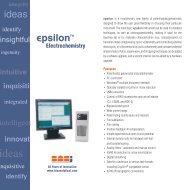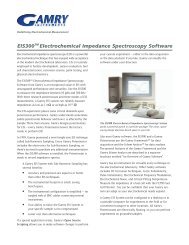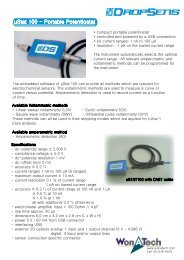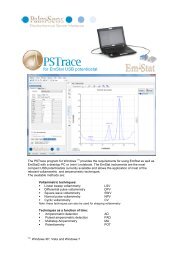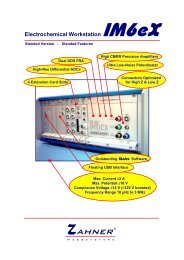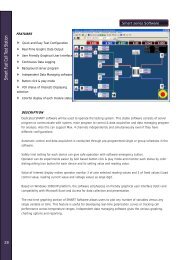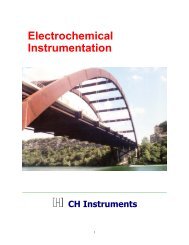for PalmSens handheld potentiostat/galvanostat - WonATech
for PalmSens handheld potentiostat/galvanostat - WonATech
for PalmSens handheld potentiostat/galvanostat - WonATech
Create successful ePaper yourself
Turn your PDF publications into a flip-book with our unique Google optimized e-Paper software.
<strong>for</strong> <strong>PalmSens</strong> <strong>handheld</strong> <strong>potentiostat</strong>/<strong>galvanostat</strong><br />
The PSTrace program <strong>for</strong> Windows (1) provides the<br />
requirements <strong>for</strong> using <strong>PalmSens</strong> as electrochemical<br />
interface by means of a desktop PC or (mini-) notebook.<br />
The instrument is connected by means of a USB or<br />
serial (RS-232) cable or by means of wireless<br />
Bluetooth.<br />
The <strong>PalmSens</strong> instrument is a battery-powered and<br />
<strong>handheld</strong> instrument which allows the application of<br />
most of the relevant voltammetric and amperometric<br />
techniques.<br />
(1) : Windows XP, Vista and Windows 7
The available methods<br />
Voltammetric techniques:<br />
• Linear sweep voltammetry LSV<br />
• Differential pulse voltammetry DPV<br />
• Square wave voltammetry SWV<br />
• Normal pulse voltammetry NPV<br />
• ac Voltammetry acV<br />
• Cyclic voltammetry CV<br />
• Stripping chronopotentiometry (or PSA) SCP<br />
Note: these techniques can also be used <strong>for</strong> stripping voltammetry<br />
Techniques as a function of time:<br />
• Amperometric detection AD<br />
• Pulsed amperometric detection PAD<br />
• Multiple pulse amperometry MPAD<br />
• Fast amperometry FAMP<br />
• Potentiometry CP<br />
• Multistep Amperometry MA<br />
• Multistep Potentiometry MP<br />
The specifications of most of the relevant parameters<br />
General pretreatment:<br />
General voltammetric parameters:<br />
Apply conditioning potential <strong>for</strong>:<br />
Apply deposition potential <strong>for</strong>:<br />
Apply begin potential <strong>for</strong>:<br />
0 – 1600 s<br />
0 – 1600 s<br />
0 – 1600 s<br />
Begin potential: -2.000 V to + 2.000 V<br />
End potential: -2.000 V to + 2.000 V<br />
Step potential: 1 mV to 250 mV<br />
Conditioning potential:<br />
Deposition potential:<br />
Standby potential:<br />
-2.000 V to + 2.000 V<br />
-2.000 V to + 2.000 V<br />
-2.000 V to + 2.000 V<br />
Pulse potential: 1 mV to 250 mV<br />
ac-amplitude: 1 mV to 250 mV<br />
Limits of some technique specific parameters <strong>for</strong> <strong>PalmSens</strong><br />
DPV and NPV: Scan rate:<br />
Pulse time:<br />
1 mV/s (1mV step) to 50 mV/s (5 mV<br />
step)<br />
10 ms to 300 ms<br />
SWV: Frequency: 1 Hz to 400 Hz<br />
SCP: Sampling rate: Approx. 40 kHz., max. 100 s<br />
LSV and CV: Scan rate: 0.2 mV/s (1 mV step) to 5 V/s (5 mV<br />
step)<br />
acV:<br />
AD and PAD:<br />
MPAD:<br />
Fast amperometry:<br />
Scan rate:<br />
Frequency:<br />
Interval time:<br />
Pulse time:<br />
Run time:<br />
Mode:<br />
Maximum number of points:<br />
Pulse times:<br />
Run time:<br />
Number of potential levels:<br />
Maximum number of points:<br />
Interval time:<br />
Maximum run time:<br />
Maximum number of points:<br />
1 mV/s (1 mV step) to 25 mV/s (5 mV<br />
step)<br />
0.12 Hz to 250 Hz<br />
10 or 50 ms to 300 s<br />
1 ms to 1 s<br />
10 s to 100000 s<br />
dc-amperometry and normal<br />
pulse and differential pulse.<br />
65000<br />
100 ms to 2 s<br />
10 s to 100000 s<br />
3<br />
65000<br />
1 ms to 1 s<br />
30 s<br />
20000
Multistep<br />
Amperometry or<br />
Potentiometry:<br />
Potentiometry at<br />
open circuit of at<br />
constant current:<br />
Interval time:<br />
Number of potential or current<br />
levels:<br />
Number of cycles:<br />
Maximum run time:<br />
Interval time:<br />
Maximum run time:<br />
100 ms to 30 s<br />
1 to 255<br />
1 to 20000<br />
100000 s<br />
10 ms to 30 s<br />
100000 s<br />
Note: some limits of parameters are set <strong>for</strong> practical reasons and can be modified on request.<br />
(1) PSTrace provides the option to measure <strong>for</strong>ward and reverse currents separately.<br />
Features<br />
The program per<strong>for</strong>ms automatic as well as interactive peak detection and shows the peak<br />
potential, height, area, and width. A linear regression or integration can be per<strong>for</strong>med on a<br />
marked part of the obtained curve. Smoothing of the measured curve is possible with a<br />
number of different levels. Two curves can be subtracted from each other.<br />
Data files can be stored and loaded. These files are standard ASCII files and can easily be<br />
imported in other programs. With each data file a file with the method parameters is created<br />
and the user can create an additional textfile (in RTF <strong>for</strong>mat) with personal comments.<br />
The program supports the CH8 multiplexer <strong>for</strong> <strong>PalmSens</strong>. Voltammetric scans can be<br />
measured on all 8 (or optionally 16) channels consecutively and stored in a single data file.<br />
Amperometric detection can be done simultaneously on all channels, with a minimum interval<br />
time of 0.25 s (<strong>for</strong> CH8) or 0.5 s (<strong>for</strong> 16 channels).<br />
The BiPot module of <strong>PalmSens</strong> is supported <strong>for</strong> amperometric detection as well as linear<br />
sweep and cyclic voltammetry. The measured curves of both working electrodes is displayed<br />
online.<br />
It is possible to use a magnetic stirrer which is controlled by <strong>PalmSens</strong> by means of the<br />
Switchbox. This stirrer is automatically switched on during the conditioning and deposition<br />
stages and switched off during the equilibration stage and measurement.<br />
Programming a sequence of measurements: PSScript<br />
The program allows users to program a sequence of measurements by using the ‘PSScript’<br />
option. Such a sequence can include different techniques and provides control commands <strong>for</strong><br />
the CH8 multiplexer as well as <strong>for</strong> the digital and analog input or output lines.
PSTrace analytical mode <strong>for</strong> quantitative analytical<br />
determinations<br />
The optional extension called ‘PSTrace Analytical’ provides the possibility to per<strong>for</strong>m<br />
quantitative voltammetric analysis means of standard addition or using a calibration curve by<br />
means of (stripping) voltammetry.<br />
The program allows simultaneous determination of up to 4 components with up to 4 standard<br />
additions or calibration curves.<br />
The plots and tables show the results of the voltammetric analysis clearly.
PSTrace corrosion mode<br />
The optional corrosion extension of the PSTrace program provides some additional<br />
techniques:<br />
- Linear polarization, from which the polarization resistance is obtained,<br />
- Tafel plots, from which the corrosion rate is obtained.<br />
The corrosion rate or polarization resistance can be obtained from the measured curve by<br />
means of drawing straight lines specified by the user or by means of a numerical fit method<br />
which optimizes the values of the corrosion parameters of the theoretical Stern-Geary<br />
equation.<br />
Other software <strong>for</strong> <strong>PalmSens</strong><br />
- PalmScan and PalmTime provide the same methods <strong>for</strong> the Pocket PC.
<strong>PalmSens</strong> instrumental specifications<br />
Controlled potential mode (<strong>potentiostat</strong>):<br />
- dc-potential range ± 2.000 V<br />
- compliance voltage ± 8.0 V<br />
- dc-potential resolution 1 mV<br />
- dc-offset error 2 mV<br />
- accuracy ≤ 0.2 %<br />
- ac-potential amplitude 1 mV to 250 mV<br />
- current ranges 1 nA to 10 mA (8 ranges)<br />
- maximum current ± 10 mA<br />
- current resolution 0.1 % of current range<br />
1 pA on lowest current range<br />
- accuracy ≤ 0.2 % of current range at 100 nA to 1 mA<br />
≤0.5 % at 10 nA and ≤ 1 % at 1 nA<br />
all with additional 0.2 % offset error<br />
Controlled current mode (<strong>galvanostat</strong>):<br />
- current ranges 1 μA to 1 mA<br />
- dc-current range -2 to + 2 times selected current range<br />
- dc-current resolution 0.1 % of selected current range<br />
- dc-offset error ≤ 0.2 %<br />
- current accuracy ≤ 0.4 %<br />
- maximum output voltage ± 8 V<br />
General:<br />
- electrometer amplifier input > 100 Gohm // 4 pF<br />
- rise time approx. 50 μs<br />
Keypad<br />
▲►▼◄ ENTER ESC and Power (7 keys)<br />
Display<br />
4 lines of 16 characters with backlight<br />
Dimensions<br />
155 mm x 85 mm x 35 mm<br />
Temperature range<br />
0º C to + 40º C<br />
Weight<br />
0.43 kg<br />
Power<br />
2 AA cells NiMH 2700 mAh <strong>for</strong> > 8 hours operation<br />
Battery charger included (6 V)<br />
Interfacing<br />
Serial cable (RS232), proprietary USB cable or Bluetooth<br />
External I/O Analog: 1 input and 1 output channel (0 V - 4.096 V)<br />
Digital: 1 input and 4 output lines<br />
Expansions<br />
A magnetic stirrer controlled by <strong>PalmSens</strong> is available <strong>for</strong> stripping analysis applications. The stirrer is<br />
switched on during the conditioning and deposition stages by means of the Switchbox.<br />
CH8 is a multiplexer <strong>for</strong> use with 2 to 8 sensors. It is connected to the <strong>PalmSens</strong> instrument. This device<br />
allows application of sensorarrays with up to eight working electrodes sharing the reference and counter<br />
electrodes, but also with eight working, eight counter and eight reference electrodes. The device can also be<br />
used with two-electrode sensorarrays. It is possible to connect two CH8 devices <strong>for</strong> use with up to 16<br />
sensors<br />
A BiPot module is available <strong>for</strong> use with two working electrodes. The second WE is kept at a constant<br />
potential and its current is simultaneously recorded in linear sweep and cyclic voltammetry as well as<br />
amperometric detection.<br />
<strong>PalmSens</strong> is expandable. The external I/O possibilities provide possibilities to control external equipment as<br />
valves, stirrers, etc.<br />
Additionally on the printed circuit board is space <strong>for</strong> an extra module. This provides the option to modify the<br />
instrument <strong>for</strong> specific sensors and applications.<br />
Please do not hesitate to contact Palm Instruments <strong>for</strong> more details: info@palmsens.com.<br />
Palm Instruments BV<br />
The Netherlands<br />
www.palmsens.com June 2011



